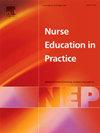Profiles of moral sensitivity and their associated factors in nursing students: A latent profile analysis
IF 3.3
3区 医学
Q1 NURSING
引用次数: 0
Abstract
Aim
This study was conducted to identify group profiles in moral sensitivity among Chinese nursing students and examine the factors associated with moral sensitivity subgroups.
Background
Moral sensitivity is a precondition for ethical decision making. Developing this sensitivity equips nursing students with the skills to identify and respond appropriately to ethical dilemmas, which are essential as they prepare to enter clinical settings. As integral members of the future nursing workforce, nursing students must be well prepared to navigate the ethical challenges they face.
Design
This study used a cross-sectional design.
Methods
Using convenience sampling, 716 nursing undergraduates from three universities in Jiangxi Province participated in this study. Participants completed online assessments of personality traits, empathy, professional nursing values and moral sensitivity. Latent profile analysis was used to identify moral sensitivity profiles and multinomial logistic regression was used to explore factors influencing distinct moral sensitivity profiles in nursing undergraduates.
Results
Results identified three profiles: “moral idealists” (9.7 %; high moral strength, moral burden; low moral responsibility), “moral undertakers” (32.0 %; moderate moral strength, moral burden; high moral responsibility), “moral skeptics” (58.3 %; low moral strength, moral burden and moral responsibility). Multinomial logistic regression analysis showed that grade level, only child status, agreeableness, conscientiousness, emotional stability, empathy and professional nursing values were associated with different profiles of moral sensitivity in nursing students.
Conclusion
Most undergraduate nursing students were placed in the moral skeptics group; thus, educational institutions should pay special attention to nursing students with low levels of moral sensitivity. Particular attention and additional support should be given to nursing students who are only children, in their lower academic years, exhibit neurotic traits and possess lower levels of agreeableness and conscientiousness. Educational activities and programs that prioritize empathy and professional nursing values may present a viable approach to fostering moral sensitivity among nursing students.
护生道德敏感性特征及其相关因素:潜在特征分析
目的探讨中国护生道德敏感性的群体特征,并探讨道德敏感性亚群的相关因素。道德敏感性是进行伦理决策的前提条件。培养这种敏感性使护理学生具备识别和适当应对道德困境的技能,这在他们准备进入临床环境时是必不可少的。作为未来护理队伍中不可或缺的一员,护理专业的学生必须做好充分的准备,以应对他们所面临的道德挑战。本研究采用横断面设计。方法采用方便抽样的方法,对江西省三所高校的716名护理本科生进行调查。参与者完成了人格特征、同理心、专业护理价值观和道德敏感性的在线评估。采用潜在特征分析识别护理本科生道德敏感性特征,采用多项逻辑回归分析探讨影响护理本科生道德敏感性特征的因素。结果确定了三种类型:“道德理想主义者”(9.7% %;道德力量高,道德负担重;低道德责任),“道德承担者”(32.0% %;道德力量适度,道德负担过重;高度的道德责任),“道德怀疑论者”(58.3% %;道德力量低,道德负担和道德责任)。多元logistic回归分析显示,年级水平、独生子女身份、宜人性、责任心、情绪稳定性、共情和专业护理价值观与护生道德敏感性的不同特征相关。结论本科护生大多处于道德怀疑组;因此,教育机构应特别关注道德敏感性低的护生。对于独生子女的护理学生,应给予特别的关注和额外的支持,在他们较低的学年,表现出神经质的特征,并具有较低水平的亲和性和责任心。优先考虑移情和专业护理价值观的教育活动和计划可能是培养护理学生道德敏感性的可行方法。
本文章由计算机程序翻译,如有差异,请以英文原文为准。
求助全文
约1分钟内获得全文
求助全文
来源期刊

Nurse Education in Practice
NURSING-
CiteScore
5.40
自引率
9.40%
发文量
180
审稿时长
51 days
期刊介绍:
Nurse Education in Practice enables lecturers and practitioners to both share and disseminate evidence that demonstrates the actual practice of education as it is experienced in the realities of their respective work environments. It is supportive of new authors and will be at the forefront in publishing individual and collaborative papers that demonstrate the link between education and practice.
 求助内容:
求助内容: 应助结果提醒方式:
应助结果提醒方式:


